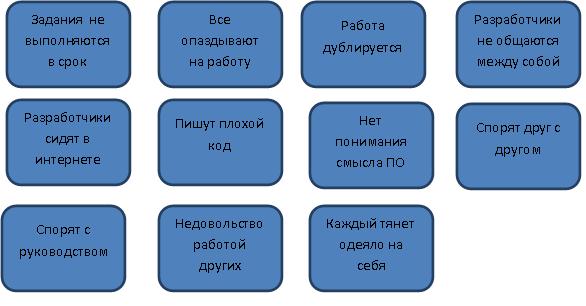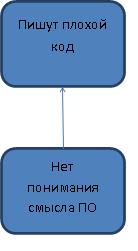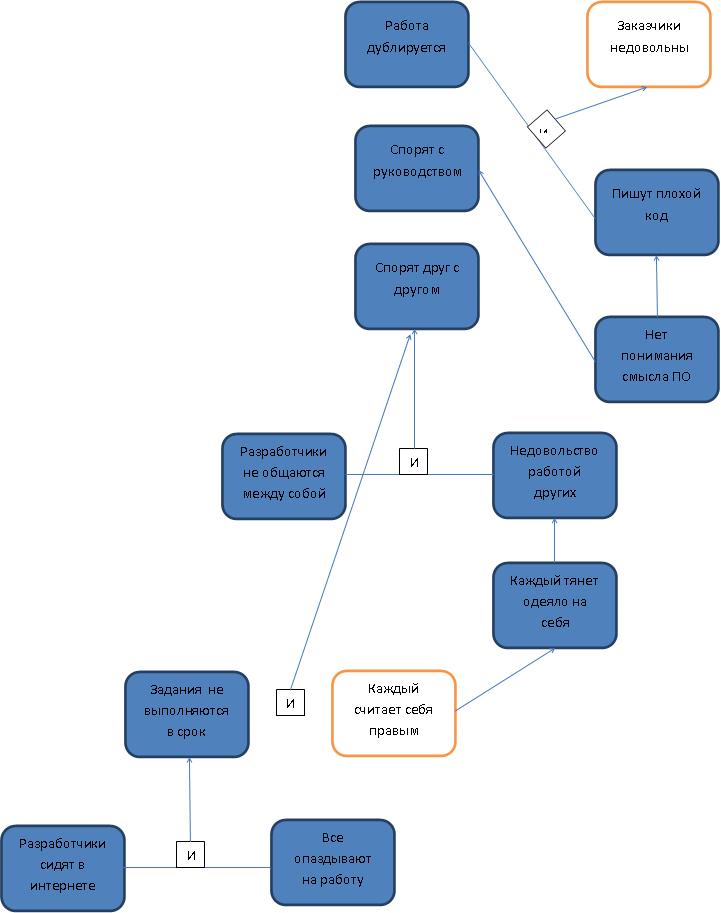Existing reality tree
All of us, at home or at work, every day (sometimes hourly) face different problems. Some of them are solved by themselves, some need to focus all their attention on a considerable time. We will talk more about the latter.
Have you ever been in a situation where you need to urgently resolve some issue, and all thoughts, as luck would have it, disappeared somewhere?
Or you have not been satisfied with, say, the results of the work of your programmers, but you cannot understand the reason?
Or do you want to resolve some question that has been tormenting you for a long time, but you do not know which way to approach it?
If you answered “yes” to at least one of the questions, then this article is for you.
I ask under the cat!
')
NB: This is the first article in the “Problem analysis and decision making” series.
NB2: The findings discussed in the example are approximate and based on a completely contrived situation.
In this first article we will discuss the method of analyzing problems with the semi-fantastic name “The Tree of Existing Reality”.
It can be described as elementary in its essence, rather complex in technical implementation and effective in terms of the results obtained. I hope you see for yourself. To the point.
You will need a board, post-it sticky notes (a large enough sheet of paper and a pen also fit, but the board is preferable) and the problem itself, which we will solve. The whole algorithm will consist of 4 steps. We will analyze them on a concrete example.
Suppose we have the following problem: "My programmers do not work!"
Step 1. Formulate the problem.
Sometimes even at this stage there are difficulties.
As you already understood what I formulated in the previous paragraph, the problem is not.
The main indicator of a properly derived problem is the ability to reformulate it into a question, the answer to which implies an action: “How can I ... (the antithesis of the problem)?”
I will explain with an example:
Initial request: My programmers are not working!
Problem: A manager cannot effectively organize the work of a team of programmers.
Test question: How can a manager effectively organize the work of a team of programmers?
Has everything come together? Go ahead.
Step 2. Write down on the board at least 10 signs (external manifestations) of your problem.
Do this on the prepared post-it sheets and arrange them in one / two lines.
Approach this step responsibly! Make sure that the signs are not "ghosts", write honestly and do not invent what is not, this is a very important condition. After a few yellow leaves (there is no friend to the taste and color) you will “burst”.
From the following 11 signs on the first 6 I spent 30 minutes of time, and for the remaining 5 minutes - 2 minutes.
Here is what happened:

Step 3. Build a Tree of Existing Reality.
The most difficult and most time-consuming step.
You need to determine the logical connection between the individual elements and arrange them in levels.
In the process of this systematization, you also need to complete some signs.
For example, the first connection is the most obvious: "They do not understand the meaning of the software, so they write bad code." Let's portray it like this:

In the same way we group the following signs.
It should be about the following. (I apologize for the quality of the pictures - due to certain circumstances, I had to draw in Word.)

Orange color indicates the signs added during the work on the tree.
Break away from the individual branches from time to time and turn your eyes on the tree entirely. So you can see the new connections between the signs.
Do not be afraid to destroy ties - new ones will take their place.
Step 4. “Pull the rope”
Besides the fact that JEM will give you a general picture of what is happening, from which you can derive certain solutions, it will also indicate the weakest point. They will be the "sheet" that defines the greatest number of links.
Press down into this place and most of the problem is solved. What to do next, I'm sure you will guess!
PS
The following 2 articles I plan to devote to the methods of "Questions of Leonardo da Vinci" and "3d-analysis."
UPD. I completely forgot to clarify that the author of this technique is the notorious E. Goldrat.
Have you ever been in a situation where you need to urgently resolve some issue, and all thoughts, as luck would have it, disappeared somewhere?
Or you have not been satisfied with, say, the results of the work of your programmers, but you cannot understand the reason?
Or do you want to resolve some question that has been tormenting you for a long time, but you do not know which way to approach it?
If you answered “yes” to at least one of the questions, then this article is for you.
I ask under the cat!
')
NB: This is the first article in the “Problem analysis and decision making” series.
NB2: The findings discussed in the example are approximate and based on a completely contrived situation.
In this first article we will discuss the method of analyzing problems with the semi-fantastic name “The Tree of Existing Reality”.
It can be described as elementary in its essence, rather complex in technical implementation and effective in terms of the results obtained. I hope you see for yourself. To the point.
You will need a board, post-it sticky notes (a large enough sheet of paper and a pen also fit, but the board is preferable) and the problem itself, which we will solve. The whole algorithm will consist of 4 steps. We will analyze them on a concrete example.
Suppose we have the following problem: "My programmers do not work!"
Step 1. Formulate the problem.
Sometimes even at this stage there are difficulties.
As you already understood what I formulated in the previous paragraph, the problem is not.
The main indicator of a properly derived problem is the ability to reformulate it into a question, the answer to which implies an action: “How can I ... (the antithesis of the problem)?”
I will explain with an example:
Initial request: My programmers are not working!
Problem: A manager cannot effectively organize the work of a team of programmers.
Test question: How can a manager effectively organize the work of a team of programmers?
Has everything come together? Go ahead.
Step 2. Write down on the board at least 10 signs (external manifestations) of your problem.
Do this on the prepared post-it sheets and arrange them in one / two lines.
Approach this step responsibly! Make sure that the signs are not "ghosts", write honestly and do not invent what is not, this is a very important condition. After a few yellow leaves (there is no friend to the taste and color) you will “burst”.
From the following 11 signs on the first 6 I spent 30 minutes of time, and for the remaining 5 minutes - 2 minutes.
Here is what happened:

Step 3. Build a Tree of Existing Reality.
The most difficult and most time-consuming step.
You need to determine the logical connection between the individual elements and arrange them in levels.
In the process of this systematization, you also need to complete some signs.
For example, the first connection is the most obvious: "They do not understand the meaning of the software, so they write bad code." Let's portray it like this:

In the same way we group the following signs.
It should be about the following. (I apologize for the quality of the pictures - due to certain circumstances, I had to draw in Word.)

Orange color indicates the signs added during the work on the tree.
Break away from the individual branches from time to time and turn your eyes on the tree entirely. So you can see the new connections between the signs.
Do not be afraid to destroy ties - new ones will take their place.
Step 4. “Pull the rope”
Besides the fact that JEM will give you a general picture of what is happening, from which you can derive certain solutions, it will also indicate the weakest point. They will be the "sheet" that defines the greatest number of links.
Press down into this place and most of the problem is solved. What to do next, I'm sure you will guess!
PS
The following 2 articles I plan to devote to the methods of "Questions of Leonardo da Vinci" and "3d-analysis."
UPD. I completely forgot to clarify that the author of this technique is the notorious E. Goldrat.
Source: https://habr.com/ru/post/137377/
All Articles